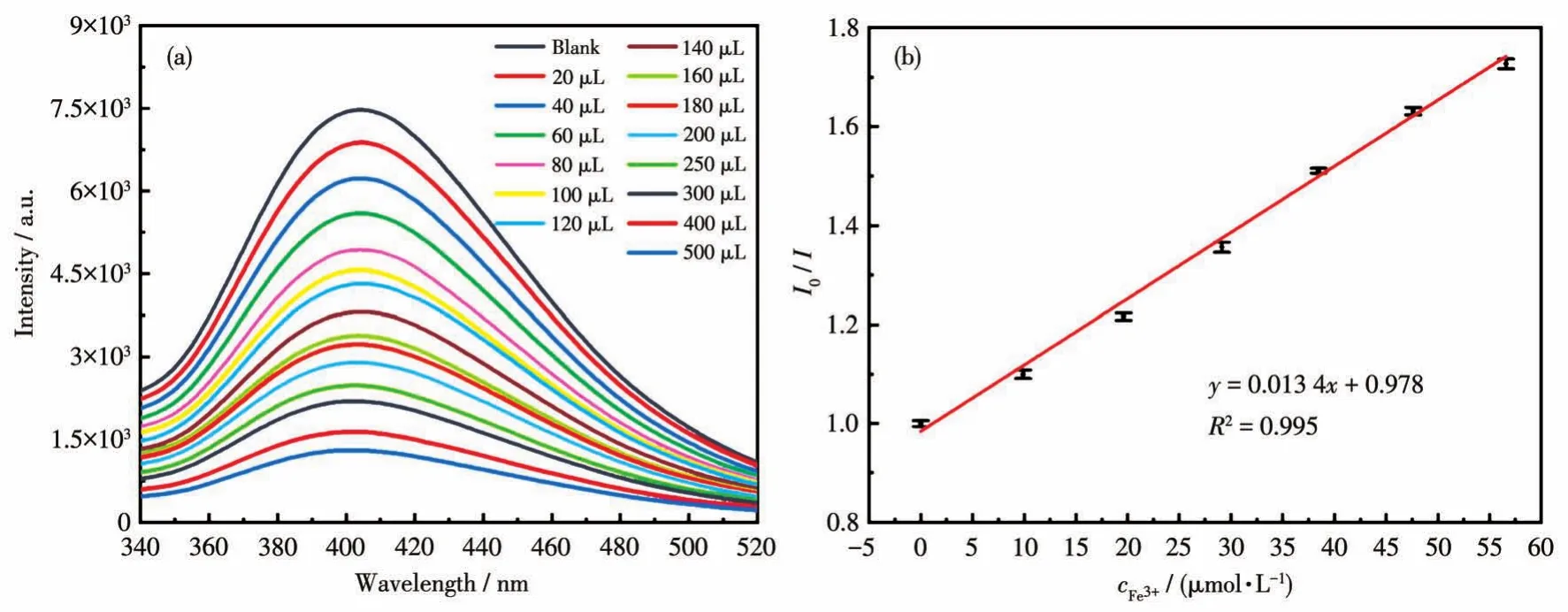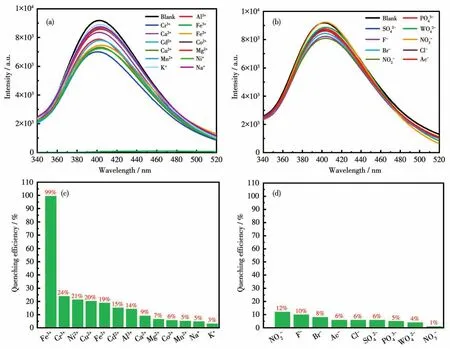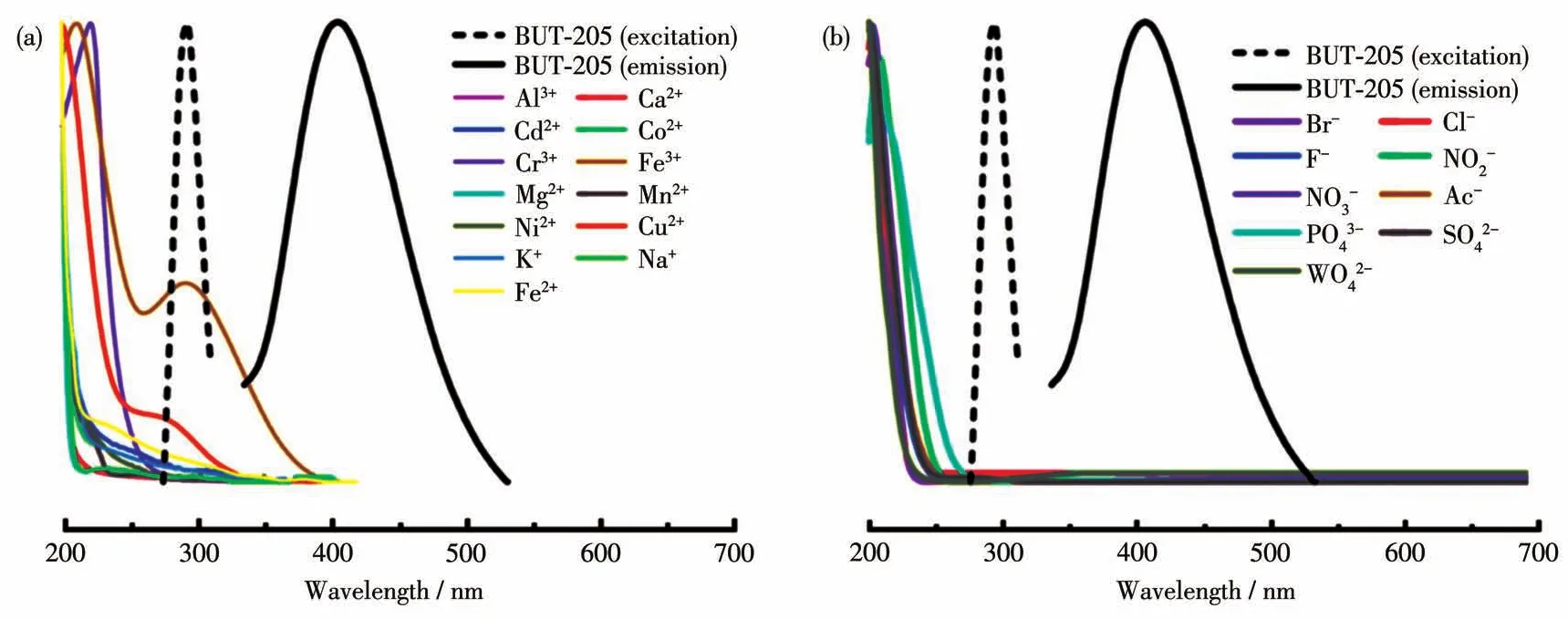一例互穿的阴离子型In(Ⅲ)金属有机骨架用于选择性检测水中Fe3+离子
2022-09-16Alamgir赵砚珑KhalidTalha谢亚勃谢林华李建荣
Alamgir 赵砚珑 Khalid Talha 谢亚勃 王 璐 谢林华 张 鑫 李建荣
(北京工业大学环境与生命学部环境化工系,绿色催化与分离北京市重点实验室,北京 100124)
0 Introduction
A large amount of wastewater produced in modern industrial activities is discharged into our environment,leading to a high threat to human health.For example,the excessive amount of Fe3+causes some serious diseases in the heart,pancreas,and liver,as well as Parkinson′s and Alzheimer′s[1-3].Various technologies have been evolved for the detection of Fe3+and fluorescence sensing is a promising technology for fast and sensitive detection,especially suitable for the rapid screening of a large number of samples by environmental control agencies[4-5].
Metal-organic frameworks(MOFs)are emerging porous materials constructed from inorganic clusters and organic linkers.Their diverse structural topologies,permanent porosity,and tunable optical properties have made them attractive materials for applications such as gas storage/separation[6-9],chemical sensing[10-11],and drug delivery[12-13].Recently,MOFs have been developed as unique materials for the recognition of metal anion/cation[14-19],persistent organic pollutants[20-21],antibiotics[22-23],and explosives[24],owing to their tunable pore size and surface functionality for selective binding of a targeted analyte to boost their sensing selectivity and sensitivity.The luminescence of MOFs can be tuned by organic linkers and metal ions.The combination of electrically nobled10metal cations with aromatic organic linkers produces MOFs with strong fluorescence for efficient sensing[25].
In the last decade,water-stable MOFs have been developed rapidly through various strategies with a deeper mechanistic understanding[26-28].MOFs constructed with high valence metals such as Zr(Ⅳ)and In(Ⅲ),have shown good stability in water,weak acid,and base solutions[29-31],which further pushed advanced applications of MOFs in aqueous media.Besides the good water stability,In-MOFs with the anionic In(COO-)4unit enables post-synthetic cation exchange as an efficient functionalization strategy[32].Such ionic nature of In-MOFs is potentially useful to promote their interaction with ionic analytes to boost the sensitivity.
Herein,we report a water-stable In(Ⅲ)-based MOF:(NH2Me2)[In(fdc)2]·2H2O(BUT-205,BUT stands for Beijing University of Technology)constructed with a furan-2,5-dicarboxylic acid(H2fdc)ligand,a biomassderived compound.The framework has a doubly interpenetrated diamondoid structure with 1D channels.The MOF showed good stability in water and exhibited sensitive and selective sensing for Fe3+in water.The LOD(limit of detection)was determined as 1.3 μmol·L-1for Fe3+,being much lower than the US-EPA(U.S.Environmental Protection Agency)standard (15.7 μmol·L-1).
1 Experimental
1.1 Reagents and general characterization
All the reagents(AR grade)were commercially available and used without further purification.FT-IR data were recorded on a SHIMADZU IR Affinity-1 instrument by using KBr pellets,and the spectra data were acquired in a range of 500-4 000 cm-1.Elemental microanalysis was performed by a Vario Macro cube Elementar.ICP-AES was performed by a PerkinElmer Optima 8000 spectrometer.The powder X-ray diffraction(PXRD)patterns were recorded on a Rigaku Smartlab3 X-ray powder diffractometer equipped with a Cu sealed tube(CuKα,λ=0.154 178 nm)with 40 kV and 30 mA at room temperature.The scanning range was from 5°to 30°.Simulation of the PXRD patterns was carried out by the single-crystal data and the diffractioncrystal module of the Mercury program available free of charge at http://www.ccdc.cam.ac.uk/mercury/.Thermogravimetric analysis(TGA)data were obtained on a TGA-50(SHIMADZU)thermogravimetric analyzer.The fluorescence spectra were recorded via an F-7000 fluorescence spectrophotometer, whose excitation source came from a xenon lamp.UV-Vis spectra were obtained with a UV-2600 spectrophotometer in a range of 200-800 nm at room temperature.
1.2 Synthesis
In(NO3)3·6H2O(15 mg,0.05 mmol),H2fdc(16 mg,0.1 mmol),and 5-aminobezotetrazole(ATZ)(8.5 mg,0.1 mmol)were ultrasonically dissolved in 2 mL of DMF in a 10 mL Pyrex vial and sealed.The mixture was then heated at 95℃for 72 h in an oven.After cooling to room temperature,the resulting colorless crystals were collected by filtration,washed with fresh DMF and acetone,and then dried in the air.The composition by inductively coupled plasma mass spectrometry(ICP-MS)and elemental analysis for C12H4InO10(NH2(CH3)2)(H2O)2was In 22.3%,C 32.8%,H 3.3%,O 38.6%,N 3.0%(Theoretical composition:In 22.7%,C 33.3%,H 3.2%,O 38.0%,N 2.8%).
1.3 Single-crystal X-ray diffraction
The X-ray diffraction data of as-synthesized BUT-205 were collected using an Agilent Supernova CCD diffractometer(a mirror monochromator,CuKαsource,λ=0.154 184 nm).The datasets were corrected by empirical absorption correction using spherical harmonics,implemented in the SCALE3 ABSPACK scaling algorithm.The structure was solved using direct methods and refined by full-matrix least-squares onF2with anisotropic displacement using the SHELXTL software package.Hydrogen atoms of the ligand were refined with isotropic displacement parameters.The disordered solvents in pores could not be modeled in terms of atomic sites but were treated by using the MASK routine in the Olex2 software package.The crystal parameters and structure refinement of BUT-205 are summarized in Table S1(Supporting information).
CCDC:2033659.
1.4 Sample activation and stability test
As-synthesized BUT-205 samples were activated by immersing first in DMF for 24 h.Then,the supernatant DMF was removed and the DMF treated samples were kept in fresh acetone for 48 h at room temperature when fresh acetone was exchanged three times a day.Finally,the sample was collected by filtration and dried for further analytical characterizations.The stability of as-synthesized BUT-205 was tested by soaking the samples in water at room temperature for 24 h.Then,the samples were collected by filtration,washed with water,and soaked in acetone for further analysis.
1.5 Fluorescence measurements
For the fluorescence quenching measurements,5 mg of finely grounded BUT-205 was added to 20 mL of deionized water and sonicated for 30 min to get a uniform suspension.For the testing of cation quenching selectivity,1 mL of cation solutions(Ca2+,Cd2+,Cu2+,Ni2+,Mn2+,Mg2+,Co2+,Al3+,Cr3+,and Fe3+)were acquainted into cuvettes pre-filled with 1 mL of BUT-205 suspension,and the mixture was agitated for homogeneity.TheKSVand LOD of Fe3+were determined by the drop-off in the fluorescence intensity of BUT-205 after consecutive addition of different amounts(0-500 μL)of Fe3+solution(1 mmol·L-1)into 2 mL of MOF suspensions in water.The interference of other cations was evaluated by the addition of 500 μL of other cations(1 mmol·L-1for each cation)into 1 mL of BUT-205 suspension,followed by the addition of 500 μL of Fe3+solution(1 mmol·L-1).
2 Results and discussion
2.1 Synthesis and structural description
Our experiment aimed at the preparation of mixed ligand MOF by using H2fdc and ATZ with indium salt.Through different protocols of various solvents and temperatures,all attempts constantly produced the crystal with a single fdc2-ligand.However,without using ATZ,we got amorphous materials after a series of attempts.Finally,we synthesized BUT-205 with a single ligand in the presence of ATZ as an essential additive in the reaction system.
The single-crystal study shows that BUT-205 crystallizes in the tetragonal crystal system with the space groupP4122 as shown in Fig.1.The asymmetric unit contains tetradentate linker fdc2-and one In3+ion.Each In3+ion is connected to eight oxygen atoms of four carboxylate groups,and each fdc2-is connected with two separate In3+ions,forming a 2-fold interpenetrated 3D framework.The In3+ion act as a 4-connected knob which is linked to each other by fdc2-to construct a diamondoid framework(Fig.S1).The topological study discovered the existence of a 4-connected In3+node and the entire architecture has adia-topological net with a point symbol{66}and can be classified as an extended Schläfli point symbol(62.62.62.62.62.62).The[In(O2C)4]can be viewed as a four-connected node with In—O distances ranging from 0.222 to 0.237 nm.Interpenetration for MOFs withdiatopology is usually observed,and some of them have shown guest response for gas separation[33-34]and sensing[35]applications.Although being doubly interpenetrated,the structure was still highly porous,with a 1D channel ofca.0.6 nm and a void space of 57.0% calculated by PLATON.Such pore size is suitable for small ions diffusion.Interestingly,such structure is also different from some other In-MOFs based on the same linker.The V-shaped linker is prone to form 2D structures rather than thediatopology.As shown in Fig.S2,1H NMR spectra show that one dimethylamine cation was found per[In(O2C)4]-cluster to keep charge balance.And the molecular formula of BUT-205,namely [In(fdc)2(NH2Me2)+(H2O)2](InC14H16O12N),was also determined along with ICP-MS,and elemental analysis.

Fig.1 Crystal of BUT-205:(a)4-connected[In(O2C)4]node and ligand(Color code:In,green;C,black;O,red);(b)perspective view of a single net with tetragonal channels;(c)view of the 2-fold interpenetrated 3D framework;(d)topological representation of 2-fold interpenetrated dia-net
2.2 PXRD and TGA
The phase purity of BUT-205 was confirmed by the PXRD pattern of as-synthesized sample which matched well with the simulated pattern from the singlecrystal structure.After treatment with water for 24 h at room temperature,the PXRD pattern of the sample remained the same as shown in Fig.2,indicating its high stability in water.BUT-205 was thermally stable up to 300℃as determined by a thermal analyzer in a temperature range of 25 to 800℃with a heating range of 10 ℃·min-1under a nitrogen atmosphere.TGA curve of BUT-205 is shown in Fig.S3a and the FT-IR spectrum is shown in Fig.S3b.

Fig.2 PXRD patterns of BUT-205
2.3 Fluorescence and sensing properties
The fluorescence property of BUT-205 has been determined at room temperature and the emission spec-trum showed an emission peak at 404 nm,whereas excited at a wavelength of 300 nm.The emission band observed for BUT-205 is likely from ligand to ligand charge transfer(n-π*andπ-π*)based on the similar fluorescence spectra between free ligand and BUT-205,as shown in Fig.S4[33].The strong fluorescence and anionic nature motivated us to explore its application of sensing Fe3+in aqueous media.
As shown in Fig.3a,the luminescence intensity of BUT-205 decreased continuously as the amount of added Fe3+solution(1 mmol·L-1)increased.To study the fluorescence quenching efficiency,the Stern-Volmer(S-V)equation(I0/I=1+KSVcFe3+)was established,whereKSVis the quenching constant,cFe3+is the concentration of Fe3+,I0andIare the fluorescence intensities of the suspension before and after the addition of Fe3+solution.The S-V plot for Fe3+displayed a good linear correlation(R2=0.995)as shown in Fig.3b.The calculatedKSVfor Fe3+was 1.34×104L·mol-1which was quite high compared with reported benchmark materials(Table S2).The LOD for Fe3+was calculated as 1.3 μmol·L-1using equation LOD=3σ/KSV,andσ(standard deviation)was calculated with three repeated fluorescence measurements of blank solution(Fig.S6).TheKSVand LOD values of BUT-205 for Fe3+ion were quite good among the reported MOF-based sensors in an aqueous medium as shown in Table S2.Especially,the LOD value for Fe3+was lower than the permissible value determined by US-EPA standards(15.7 μmol·L-1)in drinking water[36].

Fig.3 (a)Fluorescent spectra of BUT-205 suspension after the addition of different amounts of Fe3+solution(1 mmol·L-1);(b)Corresponding fitting curve of the S-V plot,where the error bar is based on three parallel experiments
Selectivity is another important factor for practical sensing applications because many other metal ions present in the analytes might also interfere with the target ions.To evaluate the sensing selectivity,the solution of cations(K+,Na+,Fe2+,Ca2+,Cd2+,Cu2+,Ni2+,Mn2+,Mg2+,Co2+,Al3+,and Cr3+)were added into the suspension of BUT-205.As a result,a small drop-off in fluorescence intensity was observed indicating low quenching efficiency.Fluorescence intensity decreased significantly when Fe3+solutions were added to the suspension respectively as shown in Fig.4a.The luminescence quenching efficiency of Fe3+was 99% while those for other cations are in a range of 3%-24%,which demonstrated the good selectivity of BUT-205 towards Fe3+(Fig.4c).Further,interference of other cations was evaluated,as shown in Fig.S5.Upon addition of other cations,the luminescence exhibited very limited quenching,which corresponds to their low quenching efficiency.Subsequently,the addition of Fe3+solution quenched 99% of the luminescence,indicating no significant interference of the sensing sensitivity from other cations.Besides,in a real water sample,there may be coexisting anions that may interfere with the sensing of Fe3+,therefore we also explored the quenching effect towards BUT-205 suspension of some common anions.As shown in Fig.4b,the solution of common anions(NO-,F-,Br-,Ac-,Cl-,SO2-,PO3-,WO2-2444and NO3-)could quench the fluorescence intensity of suspension of BUT-205 in a range of 1%-12%,which proves that the presence of anions has little effect on the fluorescence of BUT-205(Fig.4d).

Fig.4 (a)Luminescence spectra of BUT-205 upon addition of Fe3+or other cations(500 μmol·L-1);(b)Luminescence spectra of BUT-205 upon addition common anions(500 μmol·L-1);(c)Luminescence quenching efficiency of different cations(500 μmol·L-1)towards BUT-205;(d)Luminescence quenching efficiency of different anions(500 μmol·L-1)towards BUT-205
Further,UV-Vis spectra of tested ions were measured.As shown in Fig.5a,the absorption spectrum of Fe3+ion showed a broad peak in a range of 250-350 nm which overlapped with the excitation spectrum of BUT-205.Therefore,the inner filter effect(IFE)is a feasible quenching mechanism for Fe3+ions.While other cations or anions showed limited or no absorbance in this range(Fig.5a and 5b),indicating unfavorable quenching through the IFE mechanism.Especially,Fe ions of different oxidation states also exhibited distinct UV-Vis absorption with little overlap with the excitation spectrum of BUT-205,which makes the IFE quenching pathway inefficient.The emission spectrum of BUT-205 almost showed no overlap with any cations or anions(Fig.5),suggesting the Förster resonance energy transfer(FRET)mechanism is not likely to happen.

Fig.5 UV-Vis absorption spectra of tested(a)cations and(b)anions in comparison with the excitation and emission spectra of BUT-205
The reusability of a sensory material is desired for a reduced cost in practical applications.The used BUT-205 samples were recovered by centrifugation,washed with ethanol,and dried for the next test.The quenching efficiency of the regenerated sample was almost identical for four cycles as shown in Fig.6.

Fig.6 Luminescent quenching efficiency of Fe3+towards BUT-205 after four runs of regeneration experiments
3 Conclusions
In summary,a water-stable 2-fold interpenetrated 3D luminescent metal-organic framework (MOF)BUT-205 was synthesized.An open channel of about 0.6 nm can be found in this structure as revealed by single-crystal X-ray diffraction.The material exhibited sensitive and selective sensing towards Fe3+ions in water.The LOD towards Fe3+ion was calculated to be 1.3 μmol·L-1.The MOF could be recycled and reused for about four cycles without an evident loss of function.The high sensing performance,recyclability,and facile synthesis from simple precursors make the material high promising for practical sensing applications.
Conflict of interest:The authors declare no competing financial interest.
Acknowledgements:We would like to acknowledge the financial support from the Beijing Nova Program(Grant No.Z211100002121094)and the National Natural Science Foundation of China(Grants No.22038001,51621003,22108007).
Supporting information is available at http://www.wjhxxb.cn
